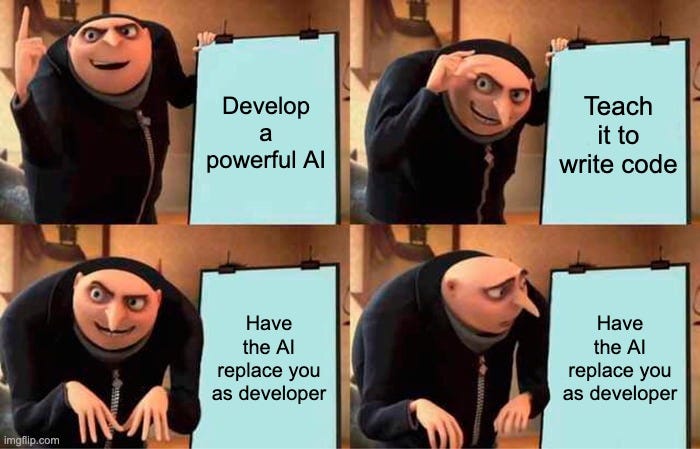Why AI Doesn't Truly Learn And How This Impacts Its Application

Table of Contents
The Illusion of Learning: How AI Algorithms Function
Current AI, particularly machine learning, excels at identifying patterns and making predictions based on vast datasets. However, this "learning" is fundamentally different from human learning. The core issue lies in the distinction between statistical correlation and causal understanding.
Statistical Correlation vs. Causal Understanding
AI algorithms primarily identify statistical correlations within data. They excel at finding relationships between variables but often fail to grasp the underlying causal mechanisms. This means AI can predict outcomes based on observed patterns without truly understanding why those patterns exist.
- Examples of AI finding correlations without understanding causality:
- A surge in ice cream sales is often correlated with an increase in drowning incidents. AI might incorrectly infer a causal link, when the true underlying factor is the hot summer weather affecting both.
- A model predicting loan defaults might identify a correlation between zip code and default rate, without understanding the socio-economic factors driving this correlation.
This lack of causal understanding significantly limits AI's ability to generalize its knowledge to new, unseen situations. An AI trained to recognize cats in a specific setting might fail to recognize a cat in a different environment or pose. It lacks the fundamental understanding of what constitutes a "cat."
Data Dependency and Bias
AI's performance is heavily reliant on the quality and quantity of data it's trained on. However, datasets often contain inherent biases reflecting societal prejudices or limitations in data collection. This leads to AI systems perpetuating and even amplifying these biases.
- Examples of biases leading to unfair or inaccurate outcomes in AI applications:
- Facial recognition systems exhibit higher error rates for individuals with darker skin tones due to biased training data.
- AI-powered loan application systems might discriminate against certain demographic groups due to biases in historical loan data.
Creating truly unbiased datasets is a significant challenge, impacting the fairness and equity of AI applications. Addressing data bias is crucial for responsible AI development.
The Impact of AI's Limited Learning on Real-World Applications
AI's inability to truly understand the world has tangible consequences across various applications. Let's examine a few key examples:
Autonomous Vehicles
Self-driving cars rely heavily on AI for perception, decision-making, and navigation. However, current AI struggles with unpredictable situations, such as unexpected pedestrian behavior or unusual weather conditions.
- Examples of accidents involving autonomous vehicles, highlighting the limitations of current AI perception and decision-making:
- A self-driving car failing to detect a pedestrian crossing unexpectedly in low-light conditions.
- An autonomous vehicle making an incorrect decision in a complex traffic scenario.
Medical Diagnosis
AI is increasingly used to assist in medical diagnosis, but its reliance on patterns without deep understanding can lead to misdiagnosis. Human expertise remains crucial in interpreting AI's findings.
- Examples where AI misdiagnosis could have severe consequences:
- AI mistaking a benign growth for a cancerous tumor.
- An AI-powered diagnostic tool missing a critical symptom leading to delayed treatment.
The importance of human oversight in medical AI cannot be overstated. AI should be a tool augmenting human expertise, not replacing it.
Customer Service Chatbots
Chatbots aim to provide efficient customer support, but their limitations in natural language understanding and problem-solving can lead to frustrating interactions.
- Examples of frustrating chatbot interactions, showcasing limitations in natural language understanding and problem-solving:
- A chatbot failing to understand a complex customer inquiry.
- A chatbot providing irrelevant or inaccurate information.
The Future of AI Learning: Towards True Understanding?
While current AI lacks true learning, ongoing research is paving the way for more robust and intelligent systems.
Advances in Explainable AI (XAI)
Explainable AI (XAI) focuses on making AI's decision-making processes more transparent and understandable. This allows developers to identify biases, debug errors, and build greater trust in AI systems.
The Role of Neuroscience and Cognitive Science
Insights from neuroscience and cognitive science can inform the development of more human-like AI systems. By studying how the human brain learns and reasons, researchers can develop new AI architectures that better emulate these capabilities.
The Need for Human-in-the-Loop Systems
Integrating human expertise into AI systems is crucial for overcoming current limitations and ensuring responsible AI development. Human-in-the-loop systems allow humans to supervise AI's decision-making, intervene when necessary, and provide feedback to improve performance.
Conclusion
In summary, current AI systems lack true learning capabilities, relying on statistical correlations rather than causal understanding. This limitation significantly impacts the reliability and effectiveness of AI in various applications. Understanding the limitations of "AI learning" is crucial for responsible development and application. Let's move beyond the hype and focus on building truly intelligent, ethical AI systems that address the shortcomings of current AI and harness its potential while mitigating its risks. Further research into AI learning limitations, true AI learning, and advancements in AI is essential to ensuring the safe and beneficial integration of AI into our lives.

Featured Posts
-
 How To Get Glastonbury 2025 Resale Tickets A Complete Guide
May 31, 2025
How To Get Glastonbury 2025 Resale Tickets A Complete Guide
May 31, 2025 -
 Dragon Dens Interest Fuels Padel Court Expansion At Chafford Hundred Health Club
May 31, 2025
Dragon Dens Interest Fuels Padel Court Expansion At Chafford Hundred Health Club
May 31, 2025 -
 Cycle News Magazine 2025 Issue 17 Read The Latest Cycling News Now
May 31, 2025
Cycle News Magazine 2025 Issue 17 Read The Latest Cycling News Now
May 31, 2025 -
 Hot Girl Cau Long Thuy Linh Doi Thu Dang Gom Tai Vong 1 Thuy Si Mo Rong 2025
May 31, 2025
Hot Girl Cau Long Thuy Linh Doi Thu Dang Gom Tai Vong 1 Thuy Si Mo Rong 2025
May 31, 2025 -
 White On Tigers Broadcast Hall Of Fame Chatter And Baseball Analysis
May 31, 2025
White On Tigers Broadcast Hall Of Fame Chatter And Baseball Analysis
May 31, 2025
